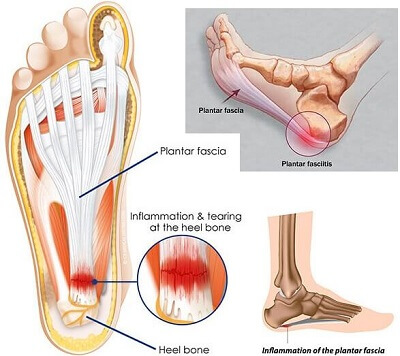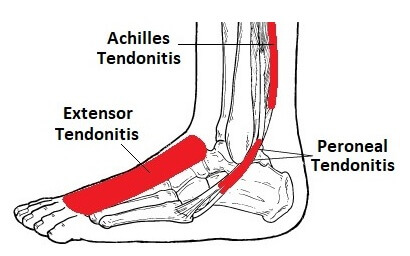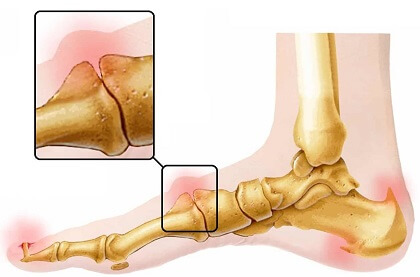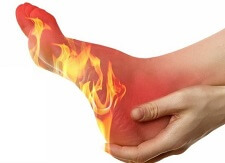- Home
- Foot Pain Symptoms
- Morning Foot Pain
Foot Pain In The Morning
Written By: Chloe Wilson BSc(Hons) Physiotherapy
Reviewed By: FPE Medical Review Board
Foot pain in the morning is a common problem which can be really unpleasant.
Inactivity overnight, having overdone things the day before, underlying medical conditions or injuries and inflammation can lead to sore feet in the morning.
Often, morning foot pain is at its worst the first few steps you take with sharp, stabbing pain that makes you hobble. But once you get moving around, things usually start to improve.
Luckily, there are lots of things you can do to help reduce the occurrence and intensity of sore feet in the morning.
So if you find yourself wincing as you take those first steps out of bed, read on to discover the reasons behind this unwelcome wake-up call and how to treat and prevent morning foot pain.
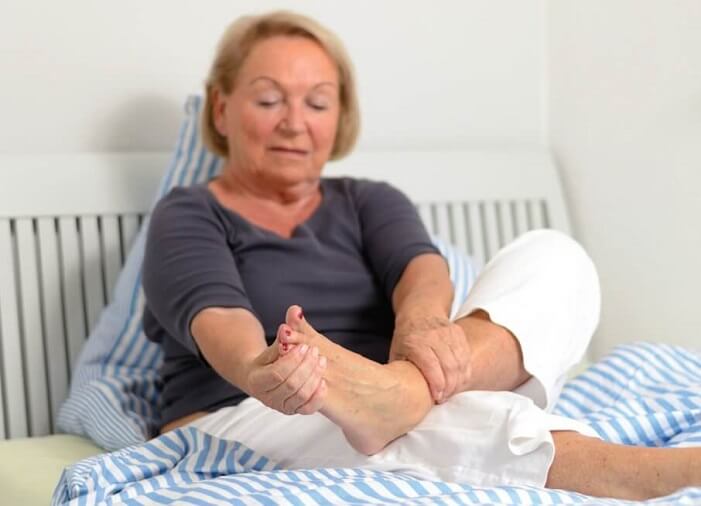
Why Is Foot Pain Worse In The Morning?
There are a number of reasons why people get foot pain in the morning:
- Reduced Blood Flow: Blood pressure and heart rate both drop overnight which reduces the flow of blood, oxygen and essential nutrients to the feet. It also means metabolic waste products are removed slower through the bloodstream which can lead to a build-up of chemicals e.g. uric acid, resulting in sore feet in the morning.
- Tissue Inflammation: Inflammation is a natural response of the body to injuries e.g. stress fractures, irritation e.g. bursitis or certain medical conditions e.g. arthritis. The body’s inflammatory response often increases during periods of rest and intensifies overnight with increased production of pro-inflammatory cytokines. This results in increased tissue inflammation and subsequent pain or discomfort upon waking up.
- Fluid Accumulation: Foot swelling often gets worse at night which leads to morning foot throbbing, tightness and discomfort. Decreased circulation, increased inflammation and lack of movement causes fluid to pool in the feet.
- Muscle & Joint Stiffness: prolonged inactivity overnight leads to muscle tightening and shortening, reduced joint lubrication and fluid build-up that results in morning foot pain and stiffness. Our joints need lubricating in order to move freely and smoothly, just like a car, and that natural joint lubricant is produced when we move. So when we stay still for long periods, the joints “dry-out”. It is only when we start moving around that joints start producing “oil” and push out excess fluid, and we stretch out the stiff joints and tight muscles.
- Overdoing It: After a particularly busy day when you’ve been on your feet a lot, even if it’s just standing or walking, it’s common to have sore feet in the morning due to a combination of fatigue, delayed onset muscle soreness or an overuse injury e.g. tendonitis.
- Wearing The Wrong Shoes: Wearing tight, narrow, ill-fitting shoes or high heels places a great deal of stress and strain through certain parts your feet which can lead to morning foot pain.
- Altered Foot Biomechanics: Having high or flat foot arches changes the way the forces go through the different structures of the feet. It can also reduce the shock absorbing capabilities of the foot and affect function.
Causes Of Morning Foot Pain
There are a number of different foot injuries and medical conditions that can cause pain in the feet in the morning. Let’s start by focussing on the five most common causes of morning foot pain and then we’ll go on to look at some of the others.
1. Plantar Fasciitis
The most common cause of foot pain in the morning is Plantar Fasciitis.
The plantar fascia is a thick band of tissue that runs along the bottom of the foot, from the heel bone to the toes, that helps to support the foot arches.
Plantar fasciitis develops when there is repetitive, excess strain through the plantar fascia which causes micro-tearing and inflammation of the fascia.
Common causes include standing for long periods, long distance running, suddenly increasing your activity levels, altered foot biomechanics, muscle tightness, age, gender and wearing shoes that lack cushioning and support.
One of the hallmark symptoms of plantar fasciitis is intense pain under the heel or in the arch of the foot, particularly when you first get up in the morning or after periods of rest.
The morning foot pain associated with plantar fasciitis occurs due to tightening and shortening of the plantar fascia overnight. As you take your first few steps, the sudden stretching of the fascia causes sharp pain. Plantar fasciitis pain typically subsides gradually as the foot warms up and the fascia stretches out, becoming more flexible.
You can find out all about the causes, symptoms and treatment options for plantar fasciitis foot pain in the morning in the Plantar Fasciitis section.
2. Arthritis
The most common cause of morning foot pain in people over the age of 60 is arthritis. There are lots of different types of arthritis that can cause foot pain in the morning, the most common being:
- Rheumatoid Arthritis: a chronic, systemic auto-immune disease where the body’s immune system mistakenly attacks joints, causing pain, inflammation and joint deformity
- Osteoarthritis: a degenerative joint disease where there is wear and tear and breakdown of the cartilage that lines the joints of the foot. Morning foot pain and stiffness is a classic feature of foot osteoarthritis e.g. hallux rigidus, big toe arthritis
- Gout: a build-up of uric acid that forms crystals in joints, especially the big toe, causing intense pain, swelling and redness. Gout foot symptoms often come on very suddenly overnight due to the drop in body temperature
Foot pain in the morning from arthritis is often at its worst when you first get up due to the build-up of inflammatory chemicals and joint stiffness from the lack of movement overnight. Morning foot pain from arthritis usually settles within an hour of getting up and moving around.
You can find out more about how gout causes foot pain in the morning and the best ways to treat it in the Foot Gout section.
3. Foot Tendonitis
Another common cause of foot pain in the morning is tendonitis. Tendons are thick, cord-like structures made of fibrous connective tissue that link muscles to bone.
The foot tendons play a vital role in transmitting the forces generated by muscles to the bones, which not only allows for movement but also provides stability. Tendons are made up of collagen fibres and are characterized by their high tensile strength which enables them to withstand the stresses and strains associated with movement and physical activities.
With foot tendonitis, there is inflammation, irritation and sometimes tearing of one of the tendons which leads to weakness and pain. Foot pain from tendonitis is often worse in the morning as the tendons become stiff and less flexible overnight. There may be stiffness and deep nagging foot pain in the morning until the tendon warms up and regains flexibility with movement.
Tendonitis is usually caused by excessive or repetitive overloading of a tendon e.g. with sports involving lots of running, jumping or kicking. Muscle tightness, weakness and abnormal foot biomechanics also increase the risk of developing tendonitis.
Morning foot pain from tendonitis can occur in any of the foot tendons but the most common types of foot tendonitis are:
- Achilles Tendonitis: The Achilles tendon connects the calf muscles to the back of the heel bone. Achilles tendonitis pain may be felt anywhere from the middle of the calf, down to the heel. Achilles tendonitis is a common cause of heel foot pain in the morning, particularly in runners or after sudden increases in activity levels
- Peroneal Tendonitis: The peroneal tendons run around the outside of the ankle and attach to side of the foot. Peroneal tendonitis is common with sports requiring quick pivoting movements such as basketball and football, or following an ankle sprain. Morning pain on the outside of the foot and ankle is often due to peroneal tendonitis
- Extensor Tendonitis: The extensor tendons run down the front of the ankle and across the top of the foot to the toes. Friction, tightness and abnormal foot arches can place a lot of pressure through the extensor tendons which sit just under the skin with little protection. Top of foot pain in the morning is often due to extensor tendonitis
- Posterior Tibial Tendonitis: The tibialis posterior tendon runs down the inner side if the ankle and attaches underneath the foot, supporting the medial foot arch. High impact sports e.g. basketball or hiking, and ankle injuries are common causes of inner ankle and foot pain in the morning from posterior tibial tendonitis
- Anterior Tibial Tendonitis: The tibialis anterior tendon runs down the front of the ankle and is the main dorsiflexor of the foot, pulling the foot upwards. Sudden increases in training and sports involving repetitive movements e.g. running and dancing can cause pain across the front of the ankle. Throbbing foot pain in the morning at the front of the ankle is often due to tibialis anterior tendonitis
Tendonitis typically affects people over the age of 40 due to the decrease in tendon elasticity and blood flow. You can find out about the different types of foot tendonitis, how they cause sore feet in the morning and how to treat them in the foot tendonitis section.
4. Bone Spurs
Another possible cause of foot pain in the morning is a bone spur, where excess bone growth forms a lump on one of the foot bones.
Bone spurs can develop anywhere in the foot but are most common on the big toe from hallux rigidus or on the heel. Heel spurs can develop either at the back of the heel by the Achilles tendon, or underneath the heel by the plantar fascia.
Bone spurs tend to form when the body is trying to repair or protect itself, e.g. from friction, pressure or tension. Common causes of bone spurs include arthritis, soft tissue tightness, ill-fitting footwear and foot injuries.
The most obvious sign of a bone spur is a hard foot lump that you can often see and feel. Bone spurs typically cause sharp foot pain in the morning when you first get up which eases off to more of a dull ache as you get moving, and the foot may feel stiff.
You can find out all about the causes of bone spur morning foot pain, the symptoms, treatment options and how to prevent them in the Foot Bone Spurs section
5. Neuropathy
Nerve irritation or damage can also cause foot pain in the morning, usually associated with tingling, numbness, burning pain and weakness in the foot. Neuropathy is where there is damage or dysfunction in one or more of the nerves somewhere along their path to the feet. This may be from compression, inflammation, trauma, infection, toxins or medical conditions.
Nerve pain in the foot may stem from a problem in the spine such as:
- Disc Disease: narrowing, bulging or herniation of the fibrocartilaginous discs that sit between bones of the spine can cause irritation or compression of the nerves as they exit the spinal column. A classic sign of a disc problem is pain when you cough or sneeze
- Spinal Stenosis: Narrowing of the spaces in the spine where the nerves run can lead to compression. A classic sign of spinal stenosis is that symptoms improve when you bend forwards or sit down
Alternatively, the nerve may be damaged anywhere along its path from the lower back to the toes, be it from an injury e.g. fracture, or a medical condition e.g. diabetes. Neuropathic pain isn’t always felt at the actual point of the damage so it is not uncommon to get symptoms of neuropathy in the feet without any back pain or upper leg symptoms.
Neuropathic pain typically gets worse at night and can result in severe foot pain in the morning. This is thought to be in part due to inflammation, but also because when you are lying down, there is much less weight going through your spine so the discs actually “plump up” as they reabsorb water, increasing in height by around 5-25mm, which can increase the compression on the nerve.
If your feet tingle in the morning or you have burning pain, numbness or weakness in your foot, then there is a high chance you have some kind of neuropathy.
You can find out more about foot pain in the morning from neuropathy including the causes, symptoms, diagnosis and treatment options in the Foot Nerve Pain section.
Other Causes Of Morning Foot Pain
There are a number of other things that can cause foot pain in the morning including:
- Bursitis: inflammation of one of the small fluid-filled sacs that sit between bone and soft tissue around the feet. There is often a small, soft pocket of swelling with bursitis, which is particularly common at the back of the heel
- Foot Cramps: Strong, involuntary muscle spasms in the feet or calves. Dehydration, vitamin and mineral imbalance, injuries, medications and medical conditions can all increase the risk of foot cramps. Poor sleep or sleeping with your knees bent up and your toes pointing down can result in cramp foot pain in the morning
- Stress Fractures: Small hairline fractures in one or more of the foot bones, usually from repetitive overuse. There is usually pain and swelling around the site of the stress fracture that is worse in the morning or after exercise
- Metatarsalgia: Irritation and inflammation underneath the metatarsal heads causing ball of foot pain.
- Hypothyroidism: Having an underactive thyroid disrupts the body’s normal chemical and hormone production which can cause autoimmune problems and inflammation. A common sign of hypothyroidism is foot pain from the associated inflammation, swelling and stiffness. Hypothyroidism can also cause tarsal tunnel syndrome where there is inflammation of the posterior tibial nerve which causes a shooting or burning pain on the bottom of the foot
- Medical Conditions: a number of other medical conditions can cause foot pain in the morning including Parkinson’s which causes muscle twitching, spasms and toe curling, and diabetes which affects circulation and blood sugar levels
#CommissionEarned from Amazon on qualifying purchases
How To Relieve & Avoid Sore Feet In The Morning
Treatment for foot pain in the morning will depend on the underlying cause but there are a number of different things you can do to help:
1. Foot Stretches
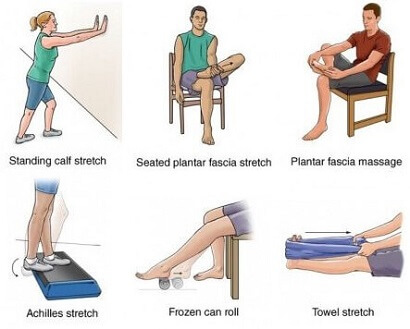
Foot stretches, ankle stretches and calf stretches help to improve the flexibility of the foot muscles and tendons, taking pressure and tension off the feet.
Ideally, you want to do stretches first thing in the morning and last thing at night to reduce the risk of having sore feet in the morning. You can find a whole range of stretches that can help in the foot stretches section.
2. Get Moving
Foot pain in the morning tends to be at its worst those first few steps you take when you get out of bed. As soon as you get moving, it increases the blood flow and lubrication for your joints. Doing some simple exercises in bed such as pointing your feet up and down, circling the ankles, bending your knees and rocking side to side can make a huge difference.
3. Ice/Heat
Applying an ice pack to the feet at night can help to reduce inflammation that has built up over the day, and applying a heat pack in the mornings helps to improve circulation and loosen up joints and soft tissues. Both can help to reduce morning foot pain. You may also find taking a warm shower helps.
4. Insoles & Orthotics
Wearing specially designed shoe inserts helps to support and cushion your feet, particularly if you have high or low foot arches, or with conditions such as plantar fasciitis. They should be worn in both shoes, even if you only have pain in one foot.
5. Night Splint
You can get specially designed foot splints to wear at night that hold the foot in a neutral position to prevent tightening of the soft tissues, which can help to reduce the chance of having sore feet in the morning.
6. Massage
Massaging your feet at the end of the day or first thing in the morning helps to ease out any tension and tightness in the feet, improve blood flow and stimulates the soft tissues. Rub oil or lotion over your feet to reduce friction and use your thumbs or knuckles to apply pressure through the foot, either by kneading, pushing down or sliding across the foot. Alternatively, you can use a massage gun.
7. Strengthening Exercises
Strengthening the calf muscles and the smaller muscles of the feet not only helps our bodies cope with being on our feet all day but also improves the support of the foot arches. Calf strengthening and foot strengthening exercises both help to reduce morning foot pain.
8. Foot Bath
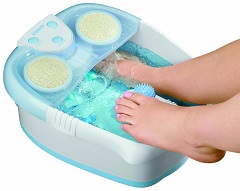
A warm foot bath, particularly if you include Epsom Salts can really help to relieve sore muscles and tired feet and can even help to reduce inflammation.
If you’ve been on your feet all day, relaxing with your feet in a nice warm foot bath can really help to reduce the risk of waking up with sore feet in the morning.
To find out more about specific treatment options for the different causes of foot pain in the morning, check out the following articles:
- Plantar Fasciitis Treatment
- Gout Prevention & Treatment
- Foot Tendonitis Treatment
- Foot Bone Spur Treatment
- Calf Strengthening Exercises & Calf Stretches
- Foot Strengthening Exercises & Foot Stretches
Foot Pain In The Morning Summary
Foot pain in the morning is a common problem that can make those first few steps each day really unpleasant.
There are a number of possible causes of morning foot pain, often linked with footwear, overuse, circulation problems, inflammation, altered foot biomechanics and joint stiffness.
Most cases of sore feet in the morning will improve fairly quickly once you get up and about as your circulation improves and the foot stretches out.
The most common cause of foot pain in the morning is plantar fasciitis which causes a sharp pain underneath the foot when you first start walking.
The location and types of pain you experience can help with working out what is going on:
- Top Of Foot Pain Morning: tendonitis, stress fractures, neuropathy, bone spurs
- Ball Of Foot Pain Morning: stress fracture, Morton’s neuroma
- Foot Arch Hurts In The Morning: plantar fasciitis, tendonitis
- Heel Pain In The Morning: achilles tendonitis, bursitis, plantar fasciitis, heel spurs
- Swollen Feet In The Morning: medical conditions e.g. gout, a foot injury e.g. stress fracture, or bursitis
- Stiff Feet In The Morning: arthritis, neuropathy, plantar fasciitis
- Feet Tingle In Morning: neuropathy, medical condition e.g. diabetes
- Toe Pain In Morning: hallux rigidus, bunions, gout
Foot pain in the morning can be relieved with a combination of stretching and strengthening exercises, orthotics, wearing supportive, comfortable footwear, massage, heat and ice.
You may also be interested in the following articles:
- Foot Lumps
- Top Of Foot Pain
- Ball Of Foot Pain
- Foot Arch Pain
- Pain On Outside Of Foot
- Heel Pain
- Toe Pain
- Foot Swelling
Related Articles
References
- Impact of routine footwear on foot health: A study on plantar fasciitis - Journal Of Family Medicine & Primary Care. 2022
- Plantar Fasciitis: A Concise View. National Library Of Medicine. 2014
- Pain Perception in Healthy Young Men Is Modified by Time-Of-Day and Is Modality Dependent - Pain Medicine Journal 2015
- Causes Of Diabetic Foot Pain - The Bone & Joint Center. June 2020
Page Last Updated: 2nd October, 2024
Next Review Due: 2nd October, 2026
